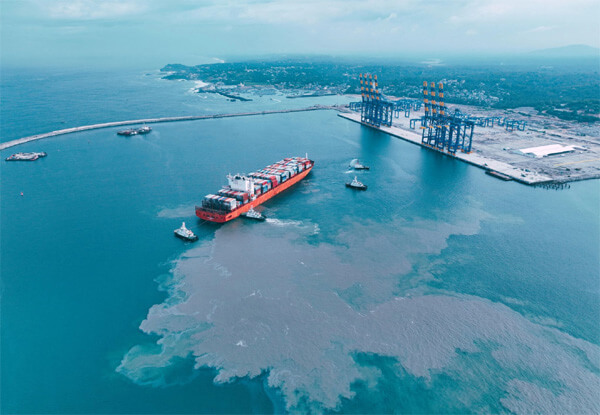India Opens Vizhinjam Transshipment Port with Arrival of Maersk Ship

India’s first new deep-water port designed to facilitate the transshipment of containers celebrated its opening today as the first vessel, operated by Maersk, was being worked alongside. Nearly a decade in the make, the Vizhinjam Port is being hailed as a landmark moment for India as it works to expand port capabilities and participate in the global transshipment market.
The Neopanamax vessel San Fernando (115,500 dwt) owned by SFL and operated by Maersk, arrived at the Vizhinjam Port on July 11 from China. The vessel, which was built in 2015 has a capacity of 8,700 TEU. According to port officials, the vessel will be offloading approximately 2,000 containers and 500 containers will be repositioned on the vessel.
While it is officially an ad-hoc port call designed to be the first pilot of the new port officials said they are in discussions with Maersk and others to start using the port full time. The ship is due to proceed to Colombo, Sri Lanka which has been Maersk’s traditional transshipment port but has been increasingly experiencing backlogs as part of the regional issues in Asia. Adani Ports which developed Vizhinjam, is presenting it as an alternative.
The construction of Vizhinjam port started in 2016 through a public-private partnership. It is located in the Kerala state near the southwestern tip of the Indian subcontinent. Officials highlight it is only 10 nautical miles from the main shipping routes meaning it is strategically placed to become India and the region’s leading transshipment port. The port has over 2,600 feet of berth and a channel that goes to a maximum depth of 79 feet (although photos show the San Fernando churning up the bottom on its arrival alongside). Port officials are saying the port can handle vessels over 18,000 TEU in capacity.

Containership maneuvering into the new port facility (Vizhinjam Port)
“The biggest ships can now berth in Vizhinjam. This positions the port as a key maritime hub in the country and globally,” said Kerala’s chief minister Pinarayi Vijayan during the opening ceremony.
Adani Group is leading the development of the port which they are saying will become the most technologically advanced, even more so than its Mundra Port, setting a new standard for India and the industry. “Once we complete the automation and Vessel Traffic Management System, Vizhinjam will be in a class of its own as one of the most technologically sophisticated transshipment ports in the world,” said Karan Adani, Managing Director of Adani Ports and SEZ Limited.
Adani Ports estimates that Vizhinjam Port is poised to handle 1.5 million TEU annually. They hope to compete with other transshipment hubs in the region such as Colombo, Dubai, and Singapore. In addition, Bloomberg is reporting Adani will invest a further $2.4 billion in the next phases of the port. Plans had called for the development to proceed in phases to 2045, but now Adani says the next phase will be completed by 2028 as they target a 3 million TEU capacity.
Although India over the years has risen into a global economic power, its major seaports have lagged. Of 12 major Indian ports, most lack the necessary infrastructure and draft to handle mega-ships. This has led to around 75 percent of India’s transshipped cargo being handled in ports outside the country including Colombo, Singapore, and Port Klang in Malaysia.
To resolve this challenge, India identified 14 new port projects for development, including deep sea terminals such as Vizhinjam. Under this initiative, India has recently approved plans to build another large container port. The $9 billion Vadhavan port will be located on the west coast north of Mumbai. It is projected to handle 23.2 million TEUs by 2040 when the second phase is completed.
